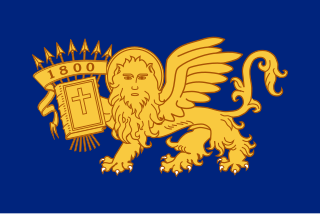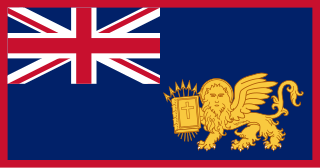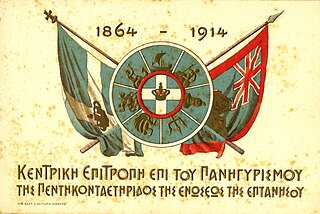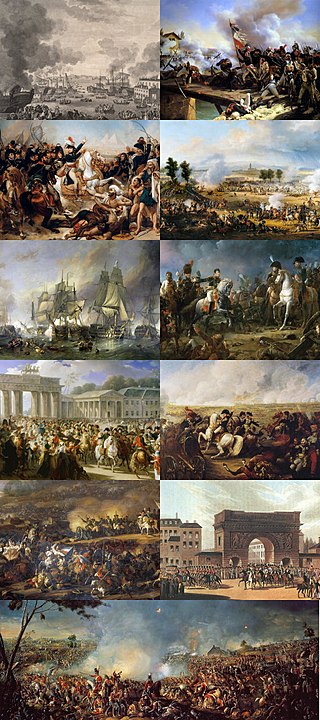
The 1790s was a decade that began on January 1, 1790, and ended on December 31, 1799. Considered as some of the Industrial Revolution's earlier days, the 1790s called for the start of an anti-imperialist world, as new democracies such as the French First Republic and the United States began flourishing at this era. Revolutions – both political and social – forever transformed global politics and art, as wars such as the French Revolutionary Wars and the American Revolutionary War moulded modern-day concepts of liberalism, partisanship, elections, and the political compass.

The Treaty of Amiens temporarily ended hostilities between France, the Spanish Empire, and the United Kingdom at the end of the War of the Second Coalition. It marked the end of the French Revolutionary Wars; after a short peace it set the stage for the Napoleonic Wars. Britain gave up most of its recent conquests; France was to evacuate Naples and Egypt. Britain retained Ceylon and Trinidad.

Enosis is an ideology calling for the incorporation of various Greek communities living outside of Greece into the Greek state. The idea is related to the Megali Idea, a concept of a Greek state that dominated Greek politics following the creation of modern Greece in 1830. The Megali Idea called for the reunification of all ethnic Greek lands, parts of which had participated in the Greek War of Independence in the 1820s but were unsuccessful and so remained under foreign rule.

The War of the Second Coalition was the second war targeting revolutionary France by many European monarchies, led by Britain, Austria, and Russia and including the Ottoman Empire, Portugal, Naples and various German monarchies. Prussia did not join the coalition, while Spain supported France.

The Treaties of Tilsit, also collectively known as the Peace of Tilsit, were two peace treaties signed by French Emperor Napoleon in the town of Tilsit in July 1807 in the aftermath of his victory at Friedland, at the end of the War of the Fourth Coalition. The first was signed on 7 July, between Napoleon and Russian Emperor Alexander I, when they met on a raft in the middle of the Neman river. The second was signed with Prussia on 9 July. The treaties were made at the expense of King Frederick William III of Prussia, who had already agreed to a truce on 25 June after the Grande Armée had captured Berlin and pursued him to the easternmost frontier of his realm.
In diplomatic history, the Eastern question was the issue of the political and economic instability in the Ottoman Empire from the late 18th to early 20th centuries and the subsequent strategic competition and political considerations of the European great powers in light of this. Characterized as the "sick man of Europe", the relative weakening of the empire's military strength in the second half of the nineteenth century threatened to undermine the fragile balance of power system largely shaped by the Concert of Europe. The Eastern question encompassed myriad interrelated elements: Ottoman military defeats, Ottoman institutional insolvency, the ongoing Ottoman political and economic modernization programme, the rise of ethno-religious nationalism in its provinces, and Great Power rivalries. In an attempt to triangulate between these various concerns, the historian Leslie Rogne Schumacher has proposed the following definition of the Eastern Question:
The "Eastern Question" refers to the events and the complex set of dynamics related to Europe's experience of and stake in the decline in political, military and economic power and regional significance of the Ottoman Empire from the latter half of the eighteenth century to the formation of modern Turkey in 1923.

The Septinsular Republic, also known as the Republic of the Seven United Islands, was an oligarchic republic that existed from 1800 to 1807 under nominal Russian and Ottoman sovereignty in the Ionian Islands.
The Treaty of Hünkâr İskelesi was a treaty signed between the Russian Empire and the Ottoman Empire on July 8, 1833, following the military aid of Russia against Muhammad Ali Pasha of Egypt that same year. The treaty brought about an alliance between the two powers, as well as a guarantee that the Ottomans would close the Dardanelles to any foreign warships if the Russians requested such action. The treaty would have significant consequences regarding the Ottoman Empire's foreign relations, especially with Great Britain and Ireland, as the terms of the treaty worried the other great powers of Europe.

The United States of the Ionian Islands was a Greek state and amical protectorate of the United Kingdom between 1815 and 1864. The successor state of the Septinsular Republic, it covered the territory of the Ionian Islands, as well as the port of Parga on the Greek mainland. It was ceded by the British to Greece as a gift to the newly enthroned King George I, apart from Parga, which had been sold to Ali Pasha of Ioannina in 1819.

The Treaty of London in 1864 resulted in the United Kingdom ceding the United States of the Ionian Islands to Greece. Britain had held an amical protectorate over the islands since the 1815 Treaty of Paris.
The foreign relations of the Ottoman Empire were characterized by competition with the Persian Empire to the east, Russia to the north, and Austria to the west. The control over European minorities began to collapse after 1800, with Greece being the first to break free, followed by Serbia. Egypt was lost in 1798–1805. In the early 20th century Austria-Hungary annexed Bosnia and Herzegovina, the Bulgarian Declaration of Independence soon followed. The Ottomans lost nearly all their European territory in the First Balkan War (1912–1913). The Ottoman Empire allied itself with the Central Powers in the World War I, and was defeated. During the war, the British successfully mobilized Arab nationalism, and the Ottoman Empire thereby lost its Arab possessions, and itself soon collapsed in the early 1920s.

The Treaty of Florence, which followed the Armistice of Foligno, brought to an end the war between the French Republic and the Kingdom of Naples, one of the Wars of the French Revolution. Forced by the French military presence, Naples ceded some territories in the Tyrrhenian Sea and accepted French garrisons to their ports on the Adriatic Sea. All Neapolitan harbours were closed to British and Ottoman vessels.

The First French Empire or French Empire, also known as Napoleonic France, was the empire ruled by Napoleon Bonaparte, who established French hegemony over much of continental Europe at the beginning of the 19th century. It lasted from 18 May 1804 to 4 April 1814 and again briefly from 20 March 1815 to 7 July 1815, when Napoleon was exiled to St. Helena.
The territorial evolution of the Ottoman Empire spans seven centuries.

A Franco-Persian alliance or Franco-Iranian alliance was formed for a short period between the French Empire of Napoleon I and Fath Ali Shah of Iran against Russia and Great Britain between 1807 and 1809. The alliance was part of a plan to gather extra aid against Russia and by Persia's help, having another front on Russia's southern borders, namely the Caucasus region. The alliance unravelled when France finally allied with Russia and turned its focus to European campaigns.

The First period of French rule in the Ionian Islands lasted from June 1797 to March 1799. Following the fall of the Republic of Venice in May 1797, the Ionian Islands, a Venetian possession, were occupied by Revolutionary France. The French instituted a new, democratic regime and, following the Treaty of Campo Formio, annexed the islands to France, forming the three departments of Corcyre (Corfu), Ithaque (Ithaca) and Mer-Égée.

The Ionian Islands were an overseas possession of the Republic of Venice from the mid-14th century until the late 18th century. The conquest of the islands took place gradually. The first to be acquired was Cythera and the neighboring islet of Anticythera, indirectly in 1238 and directly after 1363. In 1386 the Council of Corfu, which was the governing body of the island, voted to make Corfu a vassal of Venice. During the Venetian period the Council remained the most powerful institution on the island. A century later, Venice captured Zante in 1485, Cephalonia in 1500 and Ithaca in 1503. These three islands modelled their administration on Corfu's model and formed their own councils. The conquest was completed in 1718 with the capture of Lefkada. Each of the islands remained part of the Venetian Stato da Màr until Napoleon Bonaparte dissolved the Republic of Venice in 1797. The Ionian Islands are situated in the Ionian Sea, off the west coast of Greece. Cythera, the southernmost, is just off the southern tip of the Peloponnese and Corfu, the northernmost, is located at the entrance of the Adriatic Sea. It is believed that the Venetian period on the Ionian Islands was generally prosperous, especially compared with the coinciding Tourkokratia — Turkish rule over the remainder of present-day Greece.

The French Revolutionary and Napoleonic Wars, sometimes called the Great French War, were a series of conflicts between the French and several European monarchies between 1792 and 1815. They encompass first the French Revolutionary Wars against the newly declared French Republic and from 1803 onwards the Napoleonic Wars against First Consul and later Emperor Napoleon Bonaparte. They include the Coalition Wars as a subset: seven wars waged by various military alliances of European powers, known as Coalitions, against Revolutionary France – later the First French Empire – and its allies between 1792 and 1815:
The Treaty of Constantinople of 2 April [O.S. 21 March] 1800 was concluded between the Ottoman Empire and the Russian Empire, and heralded the creation of the Septinsular Republic, the first autonomous Greek state since the fall of the Byzantine Empire in 1453.












